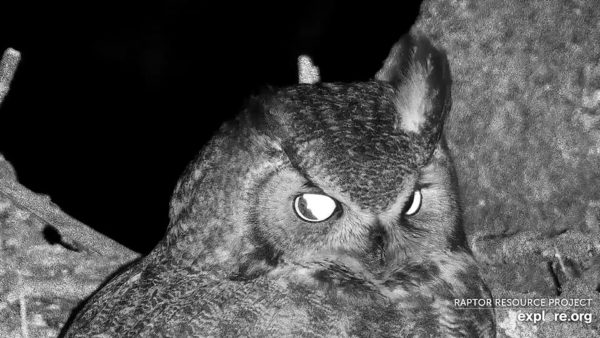Information About The Bird
Seen/Heard at
Decorah, Decorah North, Great Spirit Bluff
Diet
Great Horned Owls are non-migratory and live in the Decorah area year-round. They eat an enormous variety of prey, including rabbits, hares, mice, voles, shrews, chipmunks, a variety of squirrels, bats, skunks, domestic cats, ducks, loons, other owls, ravens, doves, and starlings – just to name a few! They supplement their diet with reptiles, insects, fish, invertebrates, and carrion.
Nesting
Great Horned Owls usually adopt a nest that was built by another species, but they may also nest in natural cavities. They line their nest with shreds of bark, leaves, and downy feathers plucked from their own breast. Since Great Horned Owls do not build or replenish nests beyond lining them, their nests tend to deteriorate over the course of the breeding season. They do not usually re-use nests.
Egg laying may begin between late January and go through early March, with most eggs laid in February in our latitude. Great Horned Owls one to four white eggs per clutch and produce one clutch per year. Females incubate eggs for 30-37 days and provide most of the care for the young, while males provision the family with food. Young leave the nest around 42 days after hatching. To learn more, visit Cornell’s website.
Great Horned Owls are able to incubate eggs successfully when outside temperatures are below -28°F/-33°C. Like Bald Eagles, Great Horned Owls don’t constantly sit their eggs, even in very cold weather. Eggs in one nest withstood the female’s absence for 20 minutes when she joined her mate to hoot at a neighboring male. The temperature was -13°F/-25°C.
Citations
Bird Range Maps of North America
Ridgely, R.S., T.F. Allnutt, T. Brooks, D.K. McNicol, D.W. Mehlman, B.E. Young, and J.R. Zook. 2003.
Digital Distribution Maps of the Birds of the Western Hemisphere, version 1.0. NatureServe, Arlington, Virginia, USA. Data provided by NatureServe in collaboration with Robert Ridgely, James Zook, The Nature Conservancy – Migratory Bird Program, Conservation International – CABS, World Wildlife Fund – US, and Environment Canada – WILDSPACE.
Web Link: http://bit.ly/2ynPQ5I
Johnsgard, P. A. 1988. North American owls: biology and natural history. Washington, D.C: Smithsonian Institution Press.
https://birdsna.org/Species-Account/bna/species/grhowl/introduction
Owl photo: By Mdf – Taken by Mdf, CC BY-SA 3.0, https://commons.wikimedia.org/w/index.php?curid=261200
General Description
Great Horned Owls have distinctive ear tufts, a white bib, a dark beak, and striking yellow eyes. They are mottled gray-brown with reddish brown figure eight faces, although their color tone varies regionally from dark to pale. Their legs and feet are covered in feathers up to the talons.
A Great Horned Owl’s overall color may reflect its environment. Paler owls often live in paler forests of predominantly birch and aspen, while darker owls often live in darker forests of predominantly pine.
Migration
Great Horned owls do not migrate.
Measurements
Length: 18.1-24.8 in/46-63 cm
Weight: 32.1-88.2 oz/910-2500 g
Wingspan: 39.8-57.1 in/101-145 cm
Wing Design
Owls have unique wing and feather features that reduce sound. Their large wings let them fly very slowly, which lessens the amount an owl needs to flap. Serrations on the leading edge of their wing feathers break up air pockets, which prevents a ‘swooshing’ sound, while the soft fringe on an owl’s trailing wing edge and the unique soft texture of its feathers streamline its body and help reduce flight-related noise. For more information, check out the owl pages!
| See also different: | Decorah Nest, Decorah North Nest, Great Spirit Bluff, Mississippi River Flyway, Owls |
